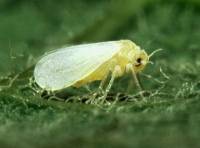This is an old revision of the document!
Table of Contents
Group 5
<html><font size=6 face=“Arial”>Third wheeling as an invasion strategy</font></html>
Wiki site of the practical exercise of the IX Southern-Summer School on Mathematical Biology.
Here you will find the exercise assignment and the group's products.
If you are a group member login to edit this page, create new pages from it, and upload files.
Introduction

Invasions of the whitefly Bemisia tabaci (left image, from Wikipedia) destroy plantations in the South of USA, Australia, China, among other countries. Several mechanisms have been isolated and tested in experimental settings to reveal their contribution to invasion.
Twelve different biotypes of whitefly have already been distinguished through phylogenetic analysis. One of these biotypes, referred to as 'B biotype', is native from Mediterranean asia and has been reported rapidly invading worldwide populations of whitefly of other biotypes. For instance, B biotype entered in both China and Australia in the 90s, where the native biotypes are ZHJ1 and AN, respectively. Interestingly, mating experiments between B and ZHJ1 and between B and AN indicated that neither could interbreed.
Liu et al. detected significant changes in sex ratio in both the indigenous and alien populations in both regions. In China, when populations of either B or ZHJ1 occurred alone, B usually had female ratios of 60~70%, which were higher than the 50~60% female ratios in ZHJ1. Very similar results also happened to AN biotype. This difference was even higher when the two different biotypes coexisted during the invasions. Then, the same group decided to reproduce this behavior in controlled environments. Their results included a B biotype domination in mixed cohorts: “The relative proportion of B increased steadily with time and had totally supplanted ZHJ1 after 225 days.” And also, it reproduces the data of sex ratios in nature.
Scientists noticed some interference behavior in whiteflies was acting as a mechanism to change sex ratios within biotypes. Although identification of the progeny produced using nuclear DNA markers detected no hybrids, demonstrating reproductive isolation between B and ZHJ1 and between B and AN, effects inter-biotypes still happened, as it was showed that B interacting with an indigenous biotype could increase production of female progeny by increasing its frequency of copulation, and at the same time could reduce the production of female progeny by the indigenous females through reducing copulation by the latter. This manipulation happened when two males from different biotypes and a female of a given biotype were placed together, the female was frequently courted by both males and courting and copulation could be interrupted by the second male - literally a third wheel.
The most significant changes occur in the following scenarios (data from Supporting Online Material of Liu et al):
- (B♂)(B♀): 6.1 copulations;
- (B♂)(B♀)(B♂): 9.3 copulations;
- (B♂)(B♀)(Z♂): 8.9 copulations;
- (Z♂)(Z♀): 3.9 copulations;
- (Z♂)(Z♀)(B♂): 2.1 copulations;
- (Z♂)(Z♀)(Z♂): 3.9 copulations;
Similar behavior to data occurred with B and AN biotypes, although numbers changed. Moreover, copulation by indigenous individuals is partly blocked by B males that readily attempt to court with females of either biotype — a behavior not reciprocated by the indigenous males.
Assignment
Propose and analyze a mathematical model for whitefly populations to investigate the strategy of changing copulation frequency in whiteflies biotypes.
Suggested questions
- Can these mating observations alone help explain biotype B's capacity to invade and displace indigenous populations? Under what circumstances do you observe B invasion in your model?
- Can your model account for the sex ratio shifts, given this mating bahavior and the fact that whiteflies are haplodiploid?
Further well-grounded questions from the group are welcome.
References
Shu-Sheng Liu, P. J. De Barro, Jing Xu, Jun-Bo Luan, Lian-Sheng Zang, Yong-Ming Ruan, Fang-Hao Wan. Asymmetric Mating Interactions Drive Widespread Invasion and Displacement in a Whitefly Science (2007), Vol. 318, Issue 5857, pp. 1769-1772. https://science.sciencemag.org/content/318/5857/1769.
